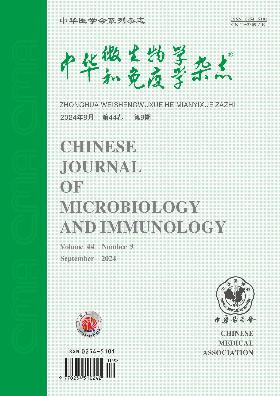Calcitonin gene-related peptide down-regulates the inflammatory response induced by lipopolysaccharide of Klebsiella pneumoniae
Q4 Immunology and Microbiology
引用次数: 0
Abstract
Objective To investigate the effects of calcitonin gene-related peptide (CGRP) on the inflammatory response induced by lipopolysaccharide (LPS) of Klebsiella pneumoniae. Methods Klebsiella pneumoniae was cultured in vitro to extracted LPS. Different concentrations of LPS were used to stimulate BEAS-2B cells. The activation of human β defensin 2 (hBD-2) in these cells was detected by immunofluorescence assay before and after adding different concentrations of CGRP. MTT assay and flow cytometry were respectively used to detect the proliferation and apoptosis of BEAS-2B cells after LPS stimulation with and without CGRP treatment. Neutrophil granules released in the cells after CGRP treatment were detected using neutrophil gelatinase-related apolipoprotein (NGAL) as the marker. Results Immunofluorescence assay results showed that LPS at different concentrations could significantly increase the relative expression of hBD-2 in BEAS-2B cells, which was significantly inhibit by CGRP intervention. LPS at 50 ng/ml, 100 ng/ml and 200 ng/ml had no significant effect on the activity of BEAS-2B cells, while treatment with 400 ng/ml of LPS for 24 h could significantly reduce the activity and promote the apoptosis of BEAS-2B cells. In addition, remarkedly increased cell activity and suppressed cell apoptosis were induced when BEAS-2B cells were treated with 10 nmol/L of CGRP in combination with LPS. LPS at different concentrations could induce the release of neutrophil-specific granules, while the LPS-induce release could be significantly inhibited by 10 nmol/L of CGRP. Conclusions CGRP could inhibit the expression of hBD-2, promote cell proliferation and reduce the degranulation of neutrophils to down-regulate the inflammatory response induced by LPS of Klebsiella pneumoniae. Key words: Klebsiella pneumoniae; Calcitonin gene-related peptide; βdefensin; Inflammatory response降钙素基因相关肽下调肺炎克雷伯菌脂多糖诱导的炎症反应
目的探讨降钙素基因相关肽(CGRP)对肺炎克雷伯菌脂多糖(LPS)诱导的炎症反应的影响。方法体外培养肺炎克雷伯菌提取脂多糖。用不同浓度的LPS刺激BEAS-2B细胞。采用免疫荧光法检测不同浓度CGRP前后人β防御素2 (hBD-2)在这些细胞中的活化情况。采用MTT法和流式细胞术分别检测CGRP处理和不处理LPS刺激后BEAS-2B细胞的增殖和凋亡情况。以中性粒细胞明胶酶相关载脂蛋白(NGAL)为标记物,检测CGRP处理后细胞中释放的中性粒细胞颗粒。结果免疫荧光分析结果显示,不同浓度的LPS均能显著提高BEAS-2B细胞中hBD-2的相对表达,而CGRP干预能显著抑制hBD-2的相对表达。50 ng/ml、100 ng/ml和200 ng/ml LPS对BEAS-2B细胞活性无显著影响,而400 ng/ml LPS处理24 h可显著降低BEAS-2B细胞活性,促进细胞凋亡。另外,10 nmol/L CGRP与LPS联合作用于BEAS-2B细胞后,细胞活性再次明显增强,细胞凋亡受到抑制。不同浓度的LPS均可诱导中性粒细胞特异性颗粒的释放,而10 nmol/L的CGRP可显著抑制LPS诱导的释放。结论CGRP可抑制hBD-2的表达,促进细胞增殖,减少中性粒细胞的脱粒,从而下调LPS诱导的肺炎克雷伯菌炎症反应。关键词:肺炎克雷伯菌;降钙素基因相关肽;βdefensin;炎症反应
本文章由计算机程序翻译,如有差异,请以英文原文为准。
求助全文
约1分钟内获得全文
求助全文
来源期刊

中华微生物学和免疫学杂志
Immunology and Microbiology-Virology
CiteScore
0.50
自引率
0.00%
发文量
6906
期刊介绍:
Chinese Journal of Microbiology and Immunology established in 1981. It is one of the series of journal sponsored by Chinese Medical Association. The aim of this journal is to spread and exchange the scientific achievements and practical experience in order to promote the development of medical microbiology and immunology. Its main contents comprise academic thesis, brief reports, reviews, summaries, news of meetings, book reviews and trends of home and abroad in this field. The distinguishing feature of the journal is to give the priority to the reports on the research of basic theory, and take account of the reports on clinical and practical skills.
 求助内容:
求助内容: 应助结果提醒方式:
应助结果提醒方式:


